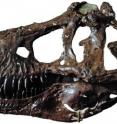Scientific understanding of T. rex revised by a decade of new research and discovery
We've all heard this story: the Late Cretaceous of Asia and North America—about 65 million years ago—was dominated by several large-headed, bipedal predatory dinosaurs like Tyrannosaurus rex and Tarbosaurus that had tiny arms. But a decade of new fossil discoveries that have more than doubled the number of known tyrannosaur species has changed this tale. Older and smaller tyrannosaurs have made the evolutionary tree of this group richer and more complex. Furthermore, a series of innovative research projects on topics like bone growth and biomechanics have added an enormous amount of information about tyrannosaurs, so much so that the group could now be considered an exemplar for studying many themes in paleontology research. A new paper describing recent research and a new evolutionary tree is published in Science this week. "T. rex is the most iconic of all dinosaurs," says Mark Norell, curator in the Division of Paleontology at the American Museum of Natural History. "Its star power has allowed a research focus into questions not normally undertaken with fossils, questions like bone growth, biomechanics, and neurology."
"We know more about tyrannosaurs than any other group of dinosaurs—even more than some groups of living organisms," says Stephen Brusatte, a graduate student affiliated with the Museum and first author of the paper. "Over the past year, five new species of tyrannosaurs have been described, and over the last ten years we have found the oldest and smallest members of the group. Now we can understand the family tree of tyrannosaurs in unprecedented detail."
The Science paper combines a new analysis of tyrannosaur phylogenetics, or their genealogy, with a review of recent research into their biology. After scoring 19 well-documented tyrannosaur fossils for over 300 different traits, the researchers developed the most comprehensive evolutionary tree of this group to date. This essentially redefined tyrannosaurs, at least when compared to the popular perception of them as large meat-eaters. Tyrannosaurs have a long evolutionary history of which the largest, T. rex, Albertosaurus, and Tarbosaurus, represent species that were ecologically dominant only during the Late Cretaceous in Asia and North America. Earlier tyrannosaurs, on the other hand, lived up to 100 million years before the large apex (top) predators, which were often small in size (some one-one hundredth of the size of T. rex and akin to a lynx in body mass), and lived all over the world.
"T. rex is really just the tip of the iceberg of tyrannosaur diversity, and honestly, is quite abnormal when compared with other members of the group. For most of their evolutionary history, tyrannosaurs were small and living in the shadow of other giant apex predators," says Brusatte. "They stayed small until the end of the Cretaceous—the final 20 million years of dinosaur history."
The new paper also reviews exciting research on tyrannosaurs, including biomechanical analyses of how quickly they could run (work of co-author John Hutchinson of the Royal Veterinary College in the U.K.), how quickly they grew (work of co-author Gregory Erickson of Florida State University and Norell), demographics of the population (Erickson), and reconstructions of the brain and neurology (work of co-authors Amy Balanoff of the American Museum of Natural History and Gabe Bever of Yale University).
"The work on tyrannosaurs underscores how much can be done using modern techniques to understand the biology of fossil organisms," says Norell. "Many of us in the field now look at ourselves as biologists who just happen to work on dinosaurs."
Source: American Museum of Natural History
Other sources
- Tyrannosaurus redux: T. rex was more than just a large carnivore at top of food chain, new findings revealfrom Science DailyFri, 17 Sep 2010, 1:28:49 UTC
- Scientific understanding of T. rex revised by a decade of new research and discoveryfrom PhysorgThu, 16 Sep 2010, 18:21:29 UTC
